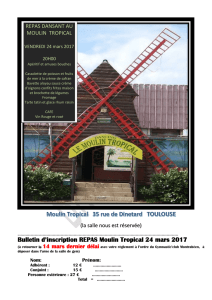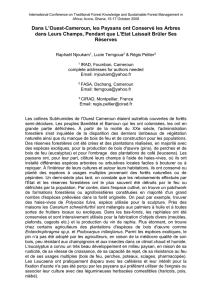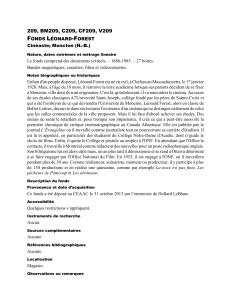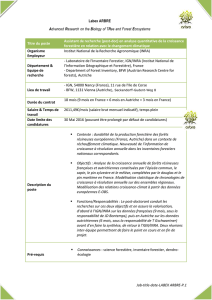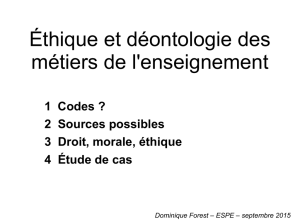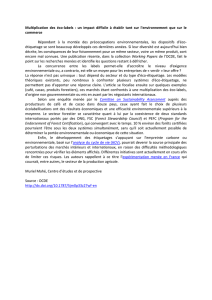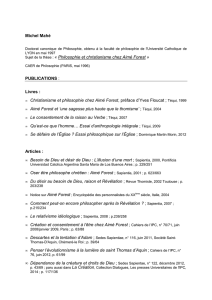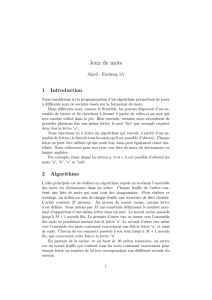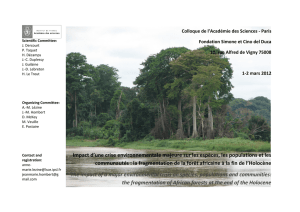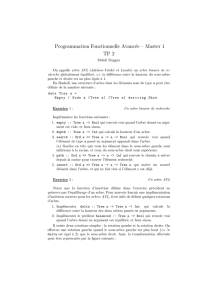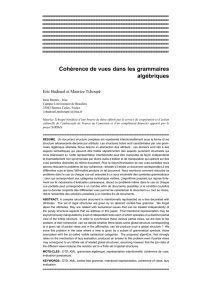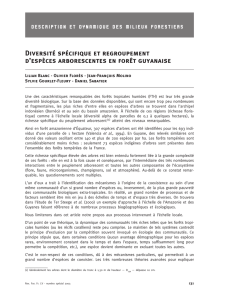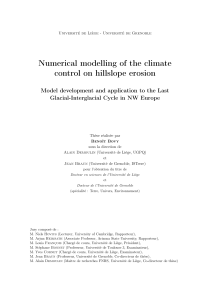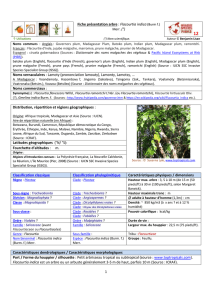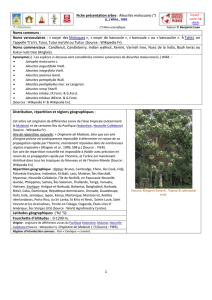Future of the tropical forest peoples : no future, since deforestation
publicité
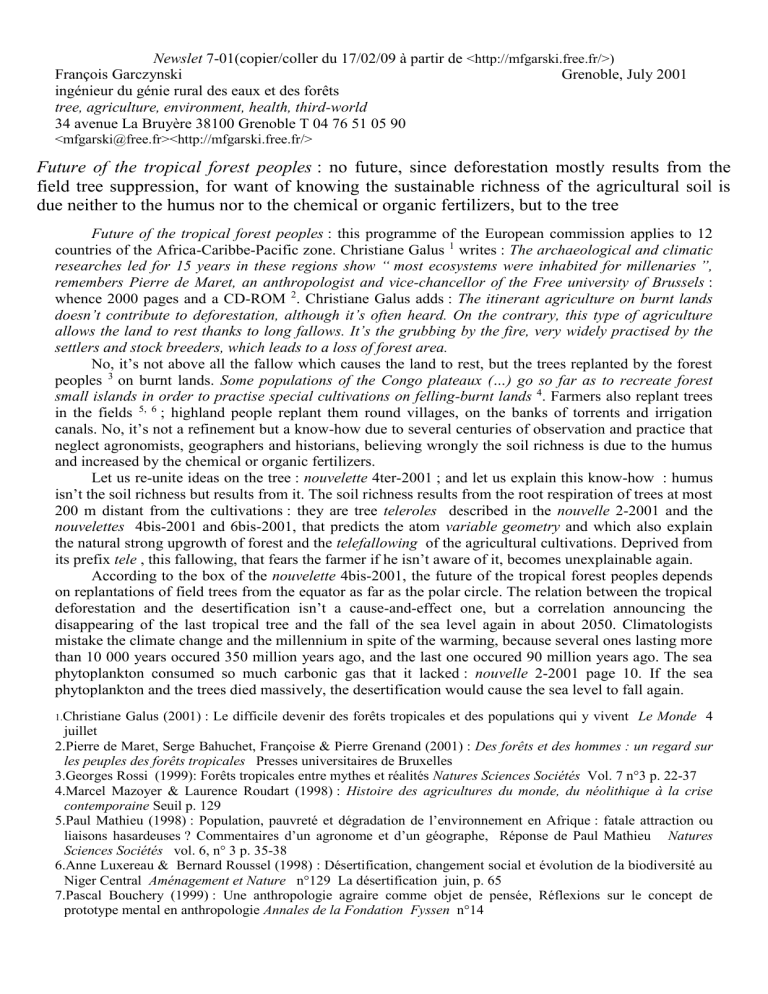
Newslet 7-01(copier/coller du 17/02/09 à partir de <http://mfgarski.free.fr/>) François Garczynski Grenoble, July 2001 ingénieur du génie rural des eaux et des forêts tree, agriculture, environment, health, third-world 34 avenue La Bruyère 38100 Grenoble T 04 76 51 05 90 <[email protected]><http://mfgarski.free.fr/> Future of the tropical forest peoples : no future, since deforestation mostly results from the field tree suppression, for want of knowing the sustainable richness of the agricultural soil is due neither to the humus nor to the chemical or organic fertilizers, but to the tree Future of the tropical forest peoples : this programme of the European commission applies to 12 countries of the Africa-Caribbe-Pacific zone. Christiane Galus 1 writes : The archaeological and climatic researches led for 15 years in these regions show “ most ecosystems were inhabited for millenaries ”, remembers Pierre de Maret, an anthropologist and vice-chancellor of the Free university of Brussels : whence 2000 pages and a CD-ROM 2. Christiane Galus adds : The itinerant agriculture on burnt lands doesn’t contribute to deforestation, although it’s often heard. On the contrary, this type of agriculture allows the land to rest thanks to long fallows. It’s the grubbing by the fire, very widely practised by the settlers and stock breeders, which leads to a loss of forest area. No, it’s not above all the fallow which causes the land to rest, but the trees replanted by the forest peoples 3 on burnt lands. Some populations of the Congo plateaux (…) go so far as to recreate forest small islands in order to practise special cultivations on felling-burnt lands 4. Farmers also replant trees in the fields 5, 6 ; highland people replant them round villages, on the banks of torrents and irrigation canals. No, it’s not a refinement but a know-how due to several centuries of observation and practice that neglect agronomists, geographers and historians, believing wrongly the soil richness is due to the humus and increased by the chemical or organic fertilizers. Let us re-unite ideas on the tree : nouvelette 4ter-2001 ; and let us explain this know-how : humus isn’t the soil richness but results from it. The soil richness results from the root respiration of trees at most 200 m distant from the cultivations : they are tree teleroles described in the nouvelle 2-2001 and the nouvelettes 4bis-2001 and 6bis-2001, that predicts the atom variable geometry and which also explain the natural strong upgrowth of forest and the telefallowing of the agricultural cultivations. Deprived from its prefix tele , this fallowing, that fears the farmer if he isn’t aware of it, becomes unexplainable again. According to the box of the nouvelette 4bis-2001, the future of the tropical forest peoples depends on replantations of field trees from the equator as far as the polar circle. The relation between the tropical deforestation and the desertification isn’t a cause-and-effect one, but a correlation announcing the disappearing of the last tropical tree and the fall of the sea level again in about 2050. Climatologists mistake the climate change and the millennium in spite of the warming, because several ones lasting more than 10 000 years occured 350 million years ago, and the last one occured 90 million years ago. The sea phytoplankton consumed so much carbonic gas that it lacked : nouvelle 2-2001 page 10. If the sea phytoplankton and the trees died massively, the desertification would cause the sea level to fall again. 1.Christiane Galus (2001) : Le difficile devenir des forêts tropicales et des populations qui y vivent Le Monde 4 juillet 2.Pierre de Maret, Serge Bahuchet, Françoise & Pierre Grenand (2001) : Des forêts et des hommes : un regard sur les peuples des forêts tropicales Presses universitaires de Bruxelles 3.Georges Rossi (1999): Forêts tropicales entre mythes et réalités Natures Sciences Sociétés Vol. 7 n°3 p. 22-37 4.Marcel Mazoyer & Laurence Roudart (1998) : Histoire des agricultures du monde, du néolithique à la crise contemporaine Seuil p. 129 5.Paul Mathieu (1998) : Population, pauvreté et dégradation de l’environnement en Afrique : fatale attraction ou liaisons hasardeuses ? Commentaires d’un agronome et d’un géographe, Réponse de Paul Mathieu Natures Sciences Sociétés vol. 6, n° 3 p. 35-38 6.Anne Luxereau & Bernard Roussel (1998) : Désertification, changement social et évolution de la biodiversité au Niger Central Aménagement et Nature n°129 La désertification juin, p. 65 7.Pascal Bouchery (1999) : Une anthropologie agraire comme objet de pensée, Réflexions sur le concept de prototype mental en anthropologie Annales de la Fondation Fyssen n°14



